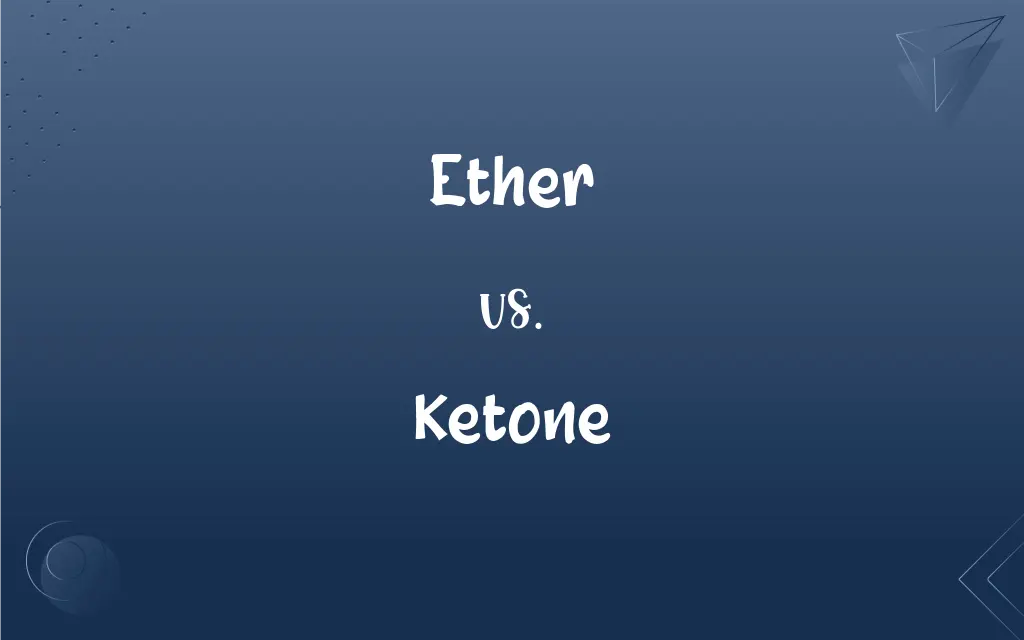Ether vs. Ketone: What's the Difference?
Edited by Aimie Carlson || By Janet White || Published on March 17, 2024
Ether is an organic compound with an oxygen atom connected to two alkyl or aryl groups. Ketone is an organic compound with a carbonyl group (C=O) bonded to two carbon atoms.

Key Differences
Ethers and ketones are both important classes of organic compounds but differ significantly in their structure and properties. Ethers are characterized by an oxygen atom that is singly bonded to two carbon atoms, which can be either alkyl or aryl groups. This structure is symbolized as R-O-R'. Ketones, on the other hand, contain a carbonyl group (C=O) where the carbon atom is double-bonded to an oxygen atom and single-bonded to two other carbon atoms. The general formula for ketones is R-CO-R', where R and R' can be the same or different alkyl or aryl groups.
One of the primary differences between ethers and ketones is their functional groups, which directly influence their chemical behavior. Ethers’ ether linkage (C-O-C) makes them relatively stable and resistant to hydrolysis, whereas ketones’ carbonyl group makes them susceptible to reactions such as nucleophilic additions. This difference in reactivity means that ethers and ketones often play different roles in organic synthesis and have different applications in industrial and laboratory settings.
Ethers are widely used as solvents, anesthetics (e.g., diethyl ether), and in the production of various chemicals. They are less polar than alcohols but more polar than alkanes, which allows them to dissolve both polar and nonpolar substances. Ketones, with their polar carbonyl group, are important solvents (e.g., acetone) and are crucial in the synthesis of other organic compounds, including pharmaceuticals and plastics.
The key distinction between ethers and ketones lies in their structure and the nature of their functional groups, leading to differences in their chemical properties, reactivity, and applications. Ethers have an oxygen atom connected to two carbon groups, while ketones feature a carbonyl group bonded to two carbon atoms, defining their roles in organic chemistry.
Comparison Chart
Functional Group
Oxygen atom bonded to two carbon atoms (R-O-R').
Carbonyl group (C=O) bonded to two carbon atoms (R-CO-R').
ADVERTISEMENT
Reactivity
Relatively low, stable compounds.
Higher reactivity due to the carbonyl group.
Applications
Used as solvents, anesthetics.
Used in organic synthesis, solvents, and manufacturing of chemicals.
Polarity
Less polar than alcohols, more polar than alkanes.
Polar due to the carbonyl group.
Chemical Behavior
Resistant to hydrolysis.
Susceptible to nucleophilic additions.
Ether and Ketone Definitions
Ether
Organic compound with an oxygen atom bonded to two alkyl or aryl groups.
Diethyl ether is commonly used as a solvent in laboratories.
ADVERTISEMENT
Ketone
Used in the manufacturing of plastics, textiles, and pharmaceuticals.
Many ketones are intermediates in the synthesis of more complex molecules.
Ether
Important in the production of pharmaceuticals and chemicals.
Ether linkages are found in many drugs and active pharmaceutical ingredients.
Ketone
Ketones are polar molecules, making them good solvents.
Due to its polarity, acetone can dissolve many organic compounds.
Ether
Characterized by their low reactivity compared to other functional groups.
The stability of ethers makes them suitable for long-term storage.
Ketone
Organic compound featuring a carbonyl group bonded to two carbon atoms.
Acetone, a simple ketone, is widely used as a solvent and in nail polish remover.
Ether
Can be symmetrical or asymmetrical based on the attached groups.
Dimethyl ether is an example of a symmetrical ether.
Ketone
Plays a crucial role in organic synthesis and chemical reactions.
The reactivity of the carbonyl group in ketones facilitates various synthetic pathways.
Ether
Used as solvents due to their ability to dissolve various substances.
Ether is prized for its effectiveness in extracting compounds.
Ketone
A substance produced by the liver during fat metabolism, used as an energy source when glucose is scarce.
During prolonged fasting, the body produces ketones to fuel the brain.
Ether
Any of a class of organic compounds in which two hydrocarbon groups are linked by an oxygen atom.
Ketone
Any of a class of organic compounds, such as acetone, characterized by having a carbonyl group in which the carbon atom is bonded to two other hydrocarbon groups and having the general formula R(CO)R′, where R may be the same as R′.
Ether
A volatile, highly flammable liquid, C4H10O, derived from distilling ethyl alcohol with sulfuric acid, used as a reagent and solvent, and formerly used as an anesthetic. Also called diethyl ether, ethyl ether.
Ketone
See ketone body.
Ketone
(organic compound) A homologous series of organic molecules whose functional group is an oxygen atom joined to a carbon atom—by a double bond—in a carbon-hydrogen based molecule.
Ketone
One of a large class of organic substances resembling the aldehydes, obtained by the distillation of certain salts of organic acids and consisting of carbonyl (CO) united with two hydrocarbon radicals. In general the ketones are colorless volatile liquids having a pungent ethereal odor.
Ketone
Any of a class of organic compounds having a carbonyl group linked to a carbon atom in each of two hydrocarbon radicals
FAQs
What is an ether?
Ether is an organic compound with an oxygen atom connected to two alkyl or aryl groups.
Can ethers form hydrogen bonds?
Ethers cannot form hydrogen bonds among themselves because they lack a hydrogen atom bonded to the electronegative oxygen.
What distinguishes an ether from an alcohol?
An ether has two carbon groups attached to an oxygen atom, while an alcohol has one carbon group attached to an oxygen-hydrogen group.
What is the significance of ketones in diabetes?
In diabetes, excessive ketone production can lead to ketoacidosis, a dangerous condition that occurs when the body lacks enough insulin.
What are common sources of ethers in nature?
Ethers are found in various natural products, including essential oils and lignin in plants.
What is the importance of ketones in organic synthesis?
Ketones are important intermediates in organic synthesis, used in various reactions such as aldol condensations.
How is ether used in everyday life?
Ether is commonly used as a solvent in laboratories and as an anesthetic in medical settings.
Can ketones be found in foods?
Yes, ketones can be found in certain foods, such as raspberries, which contain raspberry ketone.
How are ketones produced in the body?
Ketones are produced in the liver from fatty acids during periods of low food intake, carbohydrate restrictive diets, fasting, or prolonged intense exercise.
What is a ketone?
A ketone is an organic compound with a carbonyl group (C=O) bonded to two carbon atoms.
How does the structure of a ketone affect its properties?
The structure, specifically the size and electronegativity of the substituents attached to the carbonyl group, can significantly affect a ketone's reactivity and boiling point.
What are some safety concerns with ethers?
Ethers can form explosive peroxides upon exposure to air and light, requiring careful handling and storage.
What is the role of ketones in metabolism?
Ketones serve as an alternative energy source for the heart and brain when glucose is not available.
How are ethers synthesized?
Ethers can be synthesized through the dehydration of alcohols or the Williamson ether synthesis, where an alkoxide reacts with a primary alkyl halide.
Are ethers reactive?
Ethers are relatively unreactive, but they can undergo cleavage reactions under acidic conditions.
Can ethers act as solvents?
Yes, ethers are excellent solvents for a wide range of chemical reactions due to their low reactivity and good dissolving capacity.
What are polyethers and their applications?
Polyethers are polymers with ether groups in their backbone, used in making materials like polyurethane foams and resins.
What is the impact of ketone bodies in weight loss?
Ketone bodies can indicate the body is burning fat for energy, which is a principle behind ketogenic diets aimed at weight loss.
What role do ketones play in perfumery?
Ketones are used in perfumery for their sweet and floral fragrances, such as musk ketone.
How are ketones detected in a laboratory setting?
Ketones can be detected using specific chemical tests, such as the Brady's test, which involves the reaction with 2,4-dinitrophenylhydrazine to form a colored hydrazone.
About Author
Written by
Janet WhiteJanet White has been an esteemed writer and blogger for Difference Wiki. Holding a Master's degree in Science and Medical Journalism from the prestigious Boston University, she has consistently demonstrated her expertise and passion for her field. When she's not immersed in her work, Janet relishes her time exercising, delving into a good book, and cherishing moments with friends and family.
Edited by
Aimie CarlsonAimie Carlson, holding a master's degree in English literature, is a fervent English language enthusiast. She lends her writing talents to Difference Wiki, a prominent website that specializes in comparisons, offering readers insightful analyses that both captivate and inform.































































